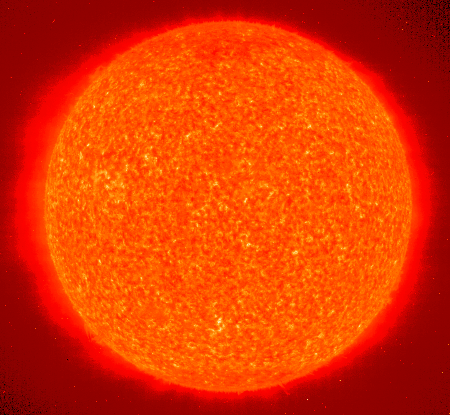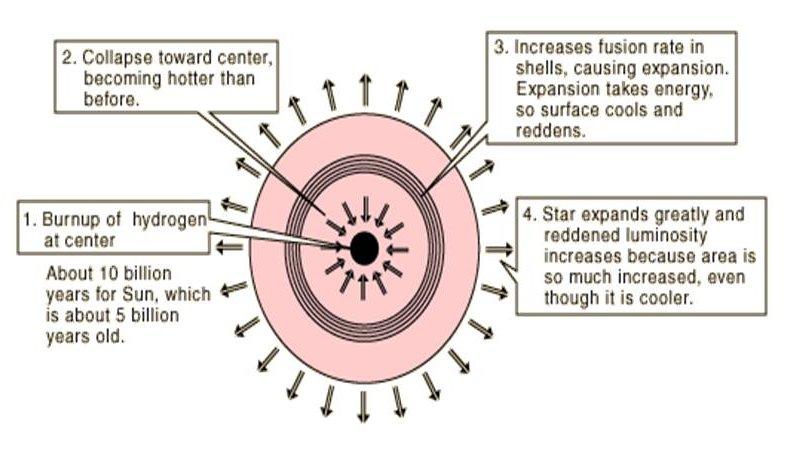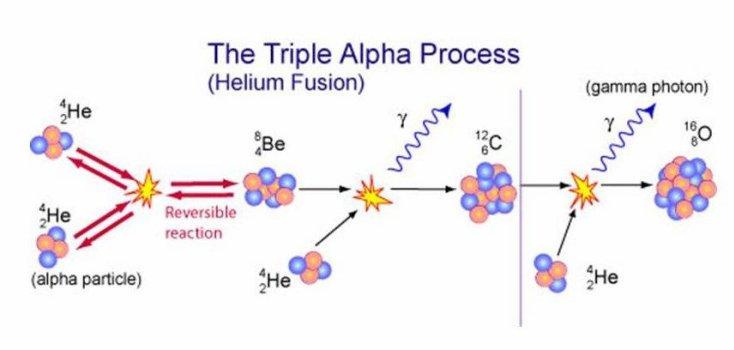 | What is a Red Giant?A red giant is a star that has a relatively low surface temperature giving it a reddish appearance. Red giants are bright and luminous non-main sequence stars located in the upper right corner of the Hertzsprung-Russell diagram. A red giant has a mass of roughly 0.5-10 solar masses and a surface temperature of about 5,000 Kelvin or lower (http://www.absoluteastronomy.com/topics/Red_giant). Finally, because red giants are more massive than main sequence stars, they have diameters between 10 and 100 times that of the Sun. In addition, they have luminosities often 1,000,000 times greater than the Sun (http://www.telescope.org/pparc/res8.html). |
Evolution of a Red Giant from a Main Sequence Star
When the main sequence star is created, it undergoes nuclear fusion. As the core in a main sequence star changes from hydrogen to helium it contracts further, increasing the temperature, while the outer layers expand and cool off. The helium core continues to contract until it reaches a temperature of about 100 million Kelvin (http://www.absoluteastronomy.com/topics/Red_giant); at this temperature, it begins fusing helium into carbon. Helium fusion occurs through the Triple Alpha Process, which combines 3 Helium atoms to 1 Carbon atom. When there is carbon in the core, the core again contracts in order to raise the temperature sufficient to undergo carbon fusion. Similar processes follow when each consecutive element (from helium to carbon to neon to oxygen to silicon to iron) of the core fuses until iron is produced. Thus, a red giant is created when the outer layers expand and cool off, giving it a low surface temperature and a reddish hue to the core.
For more information on the evolution of Red Giant stars go to:
http://www.astrophysicsspectator.com/topics/stars/RedGiantsEvolution.html
The diagram below on the left can be used to understand the evolution of a red giant from a main sequence star. This diagram can be found at (http://hyperphysics.phy-astr.gsu.edu/hbase/astro/redgia.html). | The illustration below on the right can be used to explain the various fusion layers occurring in a red giant. This illustration can be found at (http://www.pas.rochester.edu/~afrank/A105/LectureXII/LectureXII.html). |
 |  |

"The triple-alpha process is not relevant in normal (main sequence) stars like the Sun because their central temperatures are too low." However, in the red giant phase after many fusion reactions have taken place and the core has contracted multiple times, the central temperatures are high enough to initiate the triple-alpha process, fusing Helium into Carbon. Carbon then converts to Oxygen through further nuclear fusion. Therefore, majority of the heat and energy present in the red giant stars comes from the fusion of Helium and Carbon in the core. (http://csep10.phys.utk.edu/astr162/lect/energy/triplealph.html)
Refer to the diagram above for a visual representation of the Triple Alpha Process.
(Australia Telescope Outreach and Education, 2005)
Red Giants can be classified as low mass or high mass red giant stars. This may result in two different supernova explosions termed as Type I and Type II Supernova explosions. Low mass red giant stars may cause a Type 1 supernova whereas high mass red giant stars will produce a Type 11 supernova.
Type I Supernova
Low mass red giants cannot start fusing Carbon into heavier elements due to degenerate electron pressure. This degenerate electron pressure opposes the force of gravity and keeps the star from collapsing. However, the degenerate electron pressure can only act up to the mass limit of 1.4 times the mass of the Sun. When this happens, the star eventually loses its outer layers as a planetary nebula. When this nebula comes in contact with a white dwarf, they together produce a Type 1 Supernova. (Class Lecture, Stellar Evolution & Supernovae, 2008). [Both images of the Type I and Type II Supernova below on the left and right are credited to: | Type II Supernova |
 This diagram is credited to: http://astronomyonline.org/Stars/Images/AlexNervosa/PulsarFigure1.jpg.
| Degenerate Neutron PressureWhen a large amount of dense gas is present in a small volume, all electrons and protons fuse together to form neutrons. The energy that is released in this process works against the force of gravity, which makes the star stable and does not allow it to contract under the force of gravity. At this particular point the star does not have any source of energy and stays as a huge ball of gas. This is called a Neutron Star. This is possible in red giants which have a mass close to about 4 times the mass of the Sun (http://www.astro.umd.edu/educationalresources/astro/stev/degenerate.html).
|